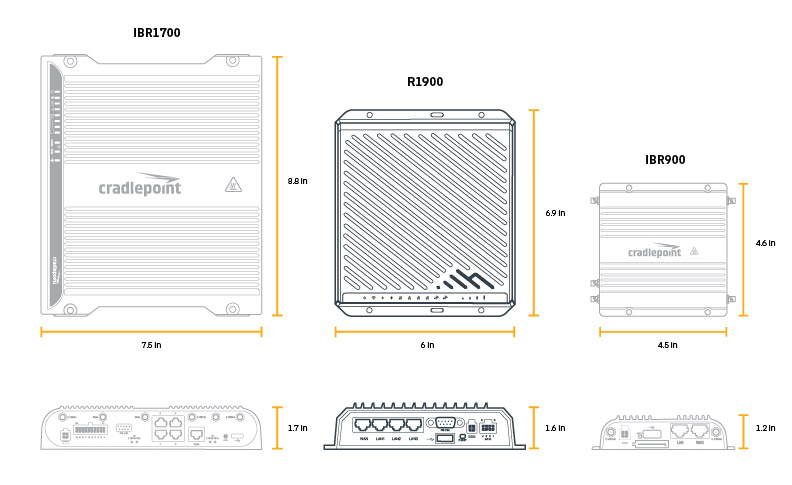Seven things to consider when upgrading your fleet connectivity to 5G
With all the press, advertisements, and, frankly, hype around 5G, it’s natural to wonder when is it actually arriving, what form will it take, and should you jump right in or take a wait and see approach. While 5G’s biggest impact is going to be on businesses and government agencies, much of what you might be reading or watching focuses on 5G for consumers — namely phones — which has added to the confusion. This uncertainty might be even more prevalent when it comes to 5G connected vehicles because they, well, move, which can complicate the process of attaining a 5G signal. But with companies like Sierra Wireless and Cradlepoint making announcements about 5G mobile routers, it’s more important than ever to know what to look for in 5G connectivity and make an informed decision about how to proceed.
We have previously written about the 5 imperatives of 5G for business, and those are still relevant for 5G-connected vehicles. But in this post I want to focus on important factors that are specific to in-vehicle connectivity. Whether you’re collecting AVL information from fleet vehicles, providing passengers Wi-Fi in buses, connecting medical equipment in an ambulance, or protecting your community in a police car, building a network in a vehicle has unique challenges. So, here are seven things to consider for 5G-connected vehicles.
Experience
As 5G is a new technology, it’s impossible to overstate the importance of experience. Make sure that any vendors you work with have not only worked with LTE, but that they worked with 5G. You don’t want your vehicles used as a testing site for a first-generation technology!
Cradlepoint has had enterprise deployments with 5G for more than a year, and the new R1900 router for 5G-connected vehicles represents our second generation of 5G products. We’ve been able to learn from our initial deployments and have factored those learnings into our next round of 5G products, both in the hardware design and the management capabilities.
Size
Good things come in small packages, and that should hold true for vehicle routers. It’s essential that the 5G router still leaves room for all the other new technology being packed into buses, police cars, and other vehicles.
The Cradlepoint R1900-5G comes in at a svelte 6.9" x 6" x 1.6”, making it ideal for smaller vehicles, those with challenging installation requirements, or big vehicles that are crowded with other tech. That’s 69% less volume and a 55% smaller footprint than the MG90 from Sierra Wireless. And this is without sacrificing ports or connectivity, as the R1900 has four high-speed ethernet ports, two Wi-Fi 6 radios, Bluetooth, 5G-level performance, and a full security stack. That’s a lot of good things in a small package.

Security
With the amount of technology in vehicles, security breaches are an ever-growing concern. A major benefit of using a 5G- or LTE-enabled router over USB modems or hotspots is the security wall that the router adds, limiting the risk of malicious actors accessing IoT in vehicles and of data such as payment information or location information being accessed in transit. Security is too important to take for granted, so make sure you’re getting strong proactive security along with 5G connectivity when you look at in-vehicle solutions.
Cradlepoint NetCloud Service for Mobile has a full suite of unified edge security capabilities within the router and via the cloud. An application-aware firewall, VPN tunnels including support for DMVPN, content filtering, IP reputation and IPS/IDS threat protection are all available with NetCloud Service for Mobile. And Cradlepoint has preintegrated with Zscaler and Palo Alto Networks, offering the best of cloud security and support for Secure Access Service Edge (SASE).
Breadth
Vehicles are only a part of any enterprise; even transit companies still have some offices. So it’s important to consider your vehicles in context with your fixed and temporary locations. Do you want to have a separate network with separate management and security policies, or do you want a cohesive edge that encompasses all your locations and IoT installations?
Cradlepoint offers 4G and 5G solutions for fixed locations, temporary locations, mobile vehicles, and IoT installations, making it an ideal solution for your entire edge. As all these share a common platform in NetCloud and a common cloud management platform in NetCloud Manager. This allows for consistent management and policies as well as a shared data plan across the entire network. And by having a solution that has been proven for all types of locations, including branches and other fixed locations, it allows mobile networks to take advantage of networking technologies such as SD-WAN, SASE, and analytics that are more prevalent in the branch but just as important for vehicle networks.
Edge compute
Vehicles are loaded with IoT and can move in and out of connectivity, making edge compute particularly important. By putting intelligence on the router, decisions can be made locally, whether Internet access exists or not, and triggering events can be acted upon quickly. It’s important to consider your edge compute needs along with your connectivity needs when looking at a new in-vehicle solution.
However, similar to security and management, with the advent of new technologies, you don’t have to treat edge compute in a vehicle as different than cloud computing. Technologies such as containers allow you to deploy modular logic across different platforms, and AWS Greengrass allows access to AWS services within a vehicle.
Cradlepoint has a robust portfolio of capabilities to support edge compute in its IBR1700 and R1900 5G mobile routers. An SDK allows for development of local Python programs, Docker container support allows for modular logic to execute locally, AWS Greengrass support allows access to AWS services locally from within a container, and an integration with Microsoft Azure IoT Central allows for intelligent upload of IoT data.
Dual-modem connectivity
Using diverse links is important in fixed locations, as a single link can fail and leaving the network without a viable connection, and this is in fact a fundamental premise of SD-WAN. And with vehicles moving around, the risk of a failure is compounded by the possibility of moving out of a single carrier’s coverage area. While capabilities such as the Cradlepoint NetCloud coverage map can help identify the best carrier for your operating region, having dual modems that allow you to connect to two different cellular networks limits the risk of ever losing connectivity.
The Cradlepoint R1900 5G mobile router can be expanded to support a second modem. Rather than adding a second modem into the base unit, and splitting the antennas so that neither modem has optimal connectivity as other products do, the R1900 is expanded through the addition of an RX30 managed accessory. This allows the full set of 4 antennas needed to have full performance for the second modem and leaves the base 5G modem with 4 antennas as well.
Performance
Antennas are only one factor to consider when looking at the performance of an in-vehicle router. One of the most distinguishing features of 5G is its fast performance. Even coverage and capacity layer spectrum promise performance greater than that of typical 4G networks. When moving to 5G, it’s important to have a solution that will support the performance of a full range of 5G spectrum both now and in the future.
The R1900 was built from the ground up to support 5G. This includes an all-new processor, more memory, gigabit Ethernet ports, four antennas per modem, and a PCI bus. This provides superior raw performance and very fast performance with security capabilities turned on and when using VPNs. Don’t accept subpar performance by using a product that wasn’t built for 5G. Don’t sacrifice one of the most exciting aspects of this new technology.
Trade up now to the leader in 5G
If you’re considering moving to 5G now, visit the R1900 webpage to learn more about this router and Cradlepoint NetCloud Service for Mobile. We’re currently offering a trade-up promotion for companies that are using a competitive product such as the Sierra Wireless MG90, so there is no better time than now to get started with 5G. Take our assessment to discover how your organization can utilize the future of wireless.
